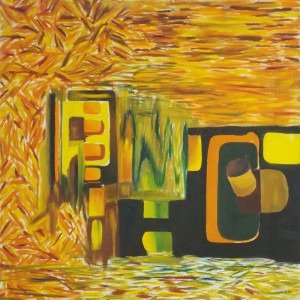I have stated in previous essays that I am a seeker of what I call PRP, Practical Religious Replacement. Taking the longest possible view, that means that the most important theme in my work and life as an artist and a thinker is that it believe we, in our short lifetimes, should work toward leaving the generations ahead the best possible planet and aggregation of knowledge we can. This means living intelligently, advancing understanding of all kinds, and making reasonable choices about our environment. If, like me you accept these premises’, then it becomes something a personal duty to, if possible, contribute to the totality of human knowledge with the best tools available to us n our time.
To that end, a small contribution I would like to make is to share a method of experiencing serenity that I have come to recognize and utilize as a source of occasional happiness and productivity in my own day to day existence. I call it “Active Randomness”. I use the term “method” loosely, for it could also be described as temporary mindset, a focus, or even a prayer-like state. Active Randomness is not a itself an activity, but rather a way of describing certain productive activities and a way of recognizing the inherent pleasure one can choose to derive from them.
Active randomness is a state of contentment that comes about when you actively engaged in a productive task that either offers or requires that a long sequencef seemingly random events contribute to the task.
What does that mean? Active Randomness describes activities where the hands are at work and the mind is fully engaged in low consequence decision-making, decisions that are perceived as being so low in consequence that no bad decision can be made. When you are engaged in a Active Random event, you can derive from it an experience of serenity and happiness that results from complete confidence that you are truly programed to succeed. It is a situation that occurs when the hands and the body are busy, the mind is fully engaged, and the outcome is guaranteed to be the desired one. And while they are usually brief experiences, I find such experiences to be both satisfying and sustaining.
I first found myself thinking about active Randomness while engaging in a classical suburban task, cutting the lawn. I have a complicated lawn with trees, shrubs, cars in the driveway and grass patterns that change with the seasons. As a result, in 20 years, I have never cut the lawn the same way twice. I decide a direction to start in and that begin to ride, making lefts and rights, circles and long lines at will and as the circumstances call on me. There are really no wrong choices, and in the end the task will be completed just as effectively and efficiently as it would have had I had a full plan and a map. Yet in applying an active random mindset to the task, I have found an inner peace with, and derived pleasure from the experience.
Now I know not many of you cut your own lawns, but this is but my grounding example. The experience is there for all of us to find and enjoy. Active Randomness is an outlook that you can apply to nearly any task that is otherwise mundane or repetitive, from painting a wall to selecting a path through the park. Can you think of task or events in your own daily existence to which this outlook may apply?
Active Randomness in Painting
Applying the concept Active Randomness to art is similar to the surrealist’s early notion of automatic painting. To create in an Active Random mode is to allow your hands and eyes to take over the part of your consciousness that wants to have a plan and follow it. However unlike finding Active Randomness in your daily life, adding it to the creative process must be deliberate. In designing an image, one must consciously allow the process of the feeling the emotion and circumstances of the moments to guide the hands in rendering patterns or colors. This can be accomplished and still adhere to the definition of being continual, moment-to-moment, low consequence decisions, but it must be noted that it is then an essentially different process from documenting isolated random acts, which is the process that was primarily employed by the pioneering abstract expressionists. Rather, an Active Randomness process seeks instantaneous input from what has already happened. Hence that actions can be taken again and again, repeated, amended, and re-guided as necessary. I apply this concept in my own creation of art regularly, but sparingly. During my early career, I allowed the concept to dominate a small collection of works, even referring to the category as Active Randomness. But as I work today, I choose primarily to seek a balanced canvas, where even my most abstract works present as visually lyrical, and hence are primarily the result of fully conscious design. At this place in my life as an artist, the consequences of most of my design decisions are simply not that low.
A final thought: Active Randomness is a mode of living…
To me, Active Randomness is a observed pleasure that increased one’s individual productivity. It is “making it up as you go along” made whole, and “whistle while you work” taken to a more reflective level. It is one of the outlooks that help me find serenity in our post-theistic world; a transcendence without prayer. You may choose to look for it in your own life, or not. It is an abstract way of thinking that will not resonate with everyone. Either way, it will be a low consequence decision.





